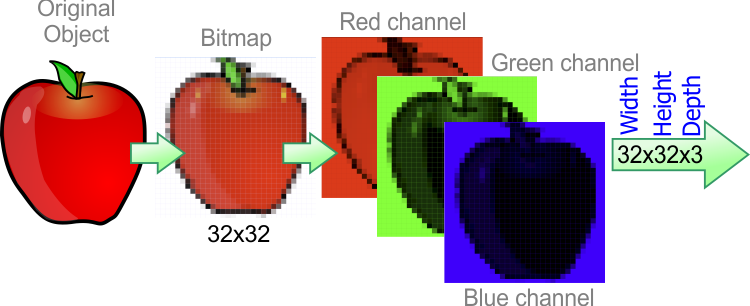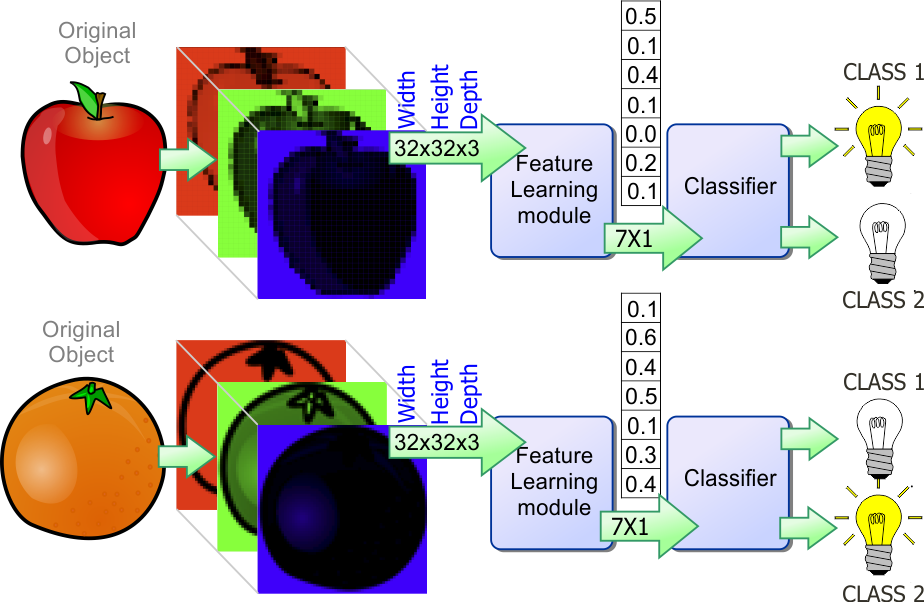Convolutional Neural Network |
| A Convolutional Neural Network (CNN) is an artificial neural network originally designed for images. However, CNNs can also be used for other applications where the data is arranged in two dimensions (i.e. text). CNNs, as multi-layer networks, are composed of layers. The theory behind is that the layers that are close to the input focus on the recognition of simple structures. While the next layers used these simple structures to recognize or detect more complex structures. The main advantage of a CNN is that the network can detect an object despite the spatial location of it. That is, a CNN is capable of detecting an object even when the object is at different positions or when the object is rotated at different angles. Una red neuronal convolucional (CNN) es una red neuronal artificial originalmente diseñada para imágenes. Sin embargo, las CNNs pueden usarse para otras aplicaciones dónde los datos estas distribuidos en dos dimensiones (por ejemplo, texto). CNNs, como las redes multicapa, están compuestas de capas o niveles. La teoría detrás es que las capas que están más cerca de la entrada se concentran en la detección de estructuras simples. Mientras que las capas siguientes usan estas estructuras simples para reconocer o detectar estructuras más complejas. La principal ventaja de una CNN es que la red puede detectar un objeto a pesar de su ubicación espacial de este. Esto es, una CNN es capaz de detectar un objeto aún cuando el objeto está en distintas posiciones o cuando el objeto está girado a ángulos diferentes. |
RGB Image |
| An Red Green Blue image can be seen as a collection of three matrices of the same size. Each matrix holds a set numeric values arranged in a 2D grid. If the three matrices are placed over to each other in the third dimension, the image can be seen as a set of 3D numbers (a volume of numbers). Thus, a CNN can also be used in applications where the data can be represented as a 3D volume. Una imagen RGB puede ser vista como una colección de tres matrices del mismo tamaño. Cada matriz contiene un conjunto de valores numéricos acomodados en una rejilla de dos dimensiones. Si las tres matrices se colocan una encima de la otra en la tercera dimensión, la imagen puede ser vista como un conjunto de números en 3D (un volumen de números). De esta forma, una CNN puede también ser usada en aplicaciones dónde los datos puedan ser representados como un volumen en 3D. |

Feature Learning |
| A CNN has two parts a: feature learning module and a classifier as shown in the figure. The feature learning module extracts the features of importance for the task at hand. The output produced by the feature learning module is typically a numeric set with very few values. Then, these features are used by a classifier to establish if the current object belongs to a specific class. The classifier typically used in a CNN is a multi-layer neural network. Una CNN tiene dos partes: un módulo de aprendizaje de características y una clasificador como se muestra en la figura. El módulo de aprendizaje de características extrae las características importante para la tarea que se desea hacer. La salida producida por el módulo de aprendizaje de características es típicamente un conjunto de números con muy pocos valores. Entonces, estas características son usadas por un clasificador para establecer si el objeto en cuestión pertenece a una clase específica. El clasificador típicamente usado en una CNN es una red neuronal multicapa. |

| Problem 1 |
Use the Internet to find one specific applications of convolutional neural networks.
Use la Internet para encontrar una aplicación específica de las redes neuronales convolucionales.
|
| Problem 2 |
Use the Internet to find out what is TensorFlow
Use la Internet para encontrar que es TensorFlow
|
| Problem 3 |
| What is difference between TensorFlow and Keras? Cual es la diferencia entre TensorFlow y Keras? |